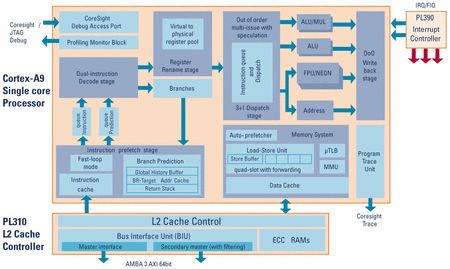Cortex-A9 SoC targets 1080p-ready Android devices
Nov 16, 2010 — by Eric Brown — from the LinuxDevices Archive — 8 viewsAmlogic has begun sampling a new system-on-chip (SoC) that combines a 1GHz ARM Cortex-A9 processor, an ARM Mali-400 GPU, and Amlogic's proprietary HD video decoding engine. Targeting next-generation consumer electronics running Linux and Android 2.2, the AML8726-M supports full 1080p HD video capabilities and a range of connectivity options, says the company.
Santa Clara, Calif.-based fabless SoC vendor Amlogic says it began began licensing key ARM technologies about a year ago, and has also utilized ARM services to aid in the development of the AML8726-M.
The resulting device is said to support devices such as tablets, set-top boxes, digital photo frames, DTVs, and other affordable, HD-ready connected devices. The SoC runs Android 2.2 and Linux, and supports OpenGL ES 2.0, the company adds.
Amlogic served up few details on the AML8726-M, although we're likely to find out more when the company ships an Android-based reference development platform, due in the first quarter of 2011.
Amlogic does say that the SoC supports 1080p video for H.264, VC-1, WMV, MPEG1/2/4, and 1080P HDMI output. Connectivity includes 10/100 Ethernet, two USB On-Thr-Go interfaces, a 3-in-1 card reader, and a SATA interface, says the company.
Software drivers are available for popular external Wi-Fi chipsets, says Amlogic. Support is said to be provided for HTML5, Adobe Flash 10.1, and Adobe AIR.
The company did release a few more details to EETimes, telling the publication that the AML8726-M clocks to 1GHz and uses 65nm fabrication. Power consumption is said to be less than two Watts, says the story.

ARM Cortex A9 in single-core configuration
(Click to enlarge)
The notion that it may be single-core is reinforced by the rather old-fashioned 65nm fabrication process. TI's Cortex-A9-based OMAP4 uses 45nm fabrication, and ARM is working on a 28nm process. Implementing the same ARMv7 architecture used on ARM's Cortex-A8, the -A9 adds ARM's MPCore interconnect layer, for support of up to four cores.
Amlogic offered no details on its proprietary HD video decoding engine, aside from the aforementioned video format support and 1080p capability. As for the ARM Mali-400 graphics processing unit (GPU) found on the AML8726-M, it is said by ARM to offer up to 800M pixel/S and 45M triangle/S performance. ARM recently announced a successor called the Mali-T604 meant to work with ARM's next-generation 2.5GHz Cortex-A15 processor.
Stated Ian Drew, executive vice president of marketing at ARM, "Amlogic has a proven track record of opening up new markets for its partners. With the new AML8726-M, Amlogic continues that tradition."
Stated John Zhong, CEO of Amlogic, "By using CPU, GPU and system IP technology from ARM, we were able to bring this new chip platform to market in record time. The ARM IP is designed with the entire SoC system in mind, which helped us minimize the development window to meet consumer demand for the next generation of electronics."
Availability
Amlogic's AML8726-M chip is available now for sampling, and an Android-based reference development platform will be available in the first quarter of 2011, says the company. More information may eventually show up at the Amlogic site, here.
The EETimes story on the Amlogic SoC may be found here.
This article was originally published on LinuxDevices.com and has been donated to the open source community by QuinStreet Inc. Please visit LinuxToday.com for up-to-date news and articles about Linux and open source.